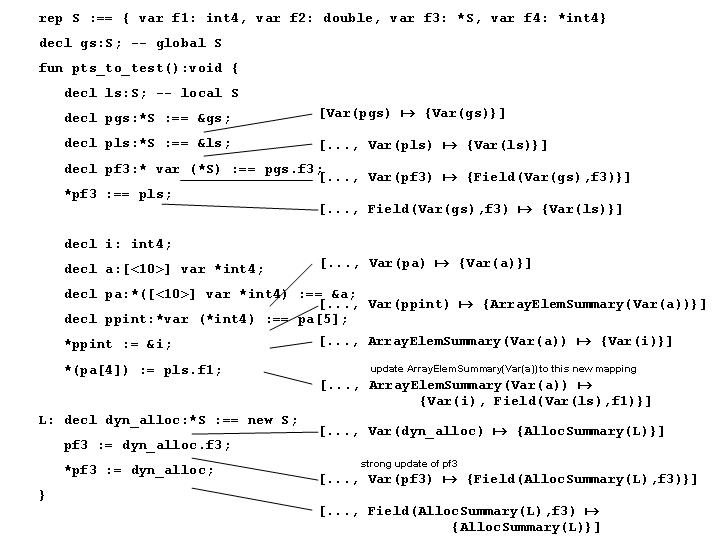

Explain in your own words how Java objects are represented in WIL. To learn how Java is translated into WIL, take a look at the simple Java example in $VORTEX_HOME/Java/src/example/src. The WIL files generated for this example by the Java-to-WIL front-end are in $VORTEX_HOME/Java/src/example/wil (just take a look at the *.wil files in this directory).
You will implement a may-points-to analysis for Whirlwind. Your analysis should track, with reasonable precision, the set of pointers between local and non-local variables, dynamically allocated memory, members of records and objects, and array elements. Your analysis should also replace a pointer dereference *p on the left- or right-hand-side of an assignment (i.e., in a TargetStoreNode or a TargetDerefNode) with a variable x (i.e., to a TargetVarAssnNode or a TargetIDExprNode) whenever it is known that p definitely points to x.
Your analysis should compute at each program point a map from locations to sets of locations. A location represents one or more run-time memory locations. A mapping [l -> {l1, l2, l3}] says that the run-time memory location(s) represented by l may contain a pointer to l1, l2, or l3. There are several kinds of locations:
The following example shows a simple program and the information your analysis should compute. Before looking at the example, there are a few things that you need to keep in mind about WIL:

The $VORTEX_HOME/Diesel/src/whirlwind/optimizations/pts-to.diesel file contains an initial skeleton implementation of this points-to analysis. You should define concrete subclasses of the abstract Location class for representing various kinds of locations, concrete subclasses of the abstract LocationSet class for representing a set of locations and supporting appropriate operations on sets of locations (perhaps along with named objects representing the top and/or bottom location sets), and concrete subclasses of the PtsTo abstract class for representing the points-to sets, i.e., mappings from locations to sets of locations (perhaps along with named objects representing the top and/or bottom points-to sets). You also should fill in the implementations of the various functions and methods with "implement me" in their bodies.
The definitions of the TargetIRNodes manipulated in this analysis is in $VORTEX_HOME/Diesel/src/whirlwind/internal-rep/nodes/ir-node.diesel and ir-node-target.diesel.
By default, points-to analysis is disabled (since it's not implemented!). You can enable it by default by changing the pts_to field's initial value to true, or by doing pts_to on at the Whirlwind> prompt, and then compiling with optimization on (e.g. using makeo1). You can also set the pts_to_msgs flag to a given level, e.g. pts_to_msgs 5, at the Whirlwind> prompt, to print out debugging information about points-to analysis. See the calls to cond_msg on options.pts_to_msgs to see the current debugging output, and feel free to add your own calls to help you monitor your analysis and transformation.
When running the compiler, you can call print_string on an object to see its "nice" string representation, and basic_print_string to see its low-level details. So, for example, if you have a TargetIDExprNode that represents a reference to variable y, then if you call print_string on it, you will get "y", and if you call basic_print_string, you will get the some string that tells you, among other things, that you're looking at a TargetIDExprNode.
Your points-to analysis should run successfully when compiling the existing WIL regression test file, test.wil.
You also should be able to run your optimization on the Java Towers-of-Hanoi benchmark. You can do that by adding its location to Whirlwind's source paths (expand $VORTEX_HOME to its real value in the commands below) and then compiling towers.wil with optimization on:
Whirlwind> append source_paths $VORTEX_HOME/Java/src/example/wil $VORTEX_HOME/Java/wil-stdlib ... Whirlwind> makeo1 towers.wil ...
You also should construct your own points-to test code, pts-to-test.wil, which exercises your analysis and optimization and shows off what it can do, and also that it doesn't do anything wrong in tricky situations. Use comments in the test file to describe what should happen and not happen.